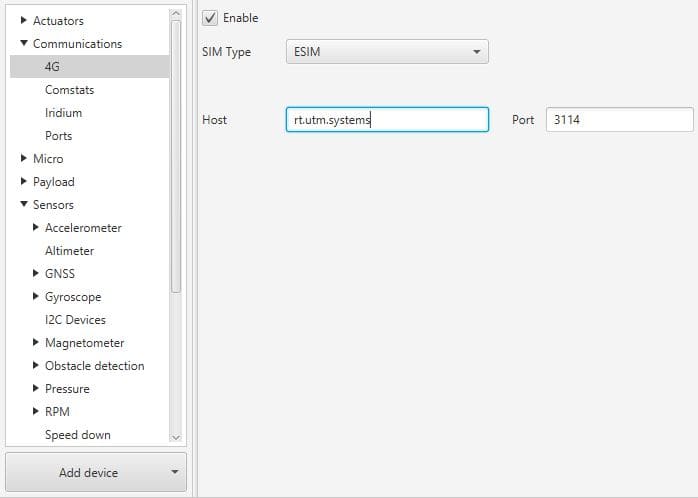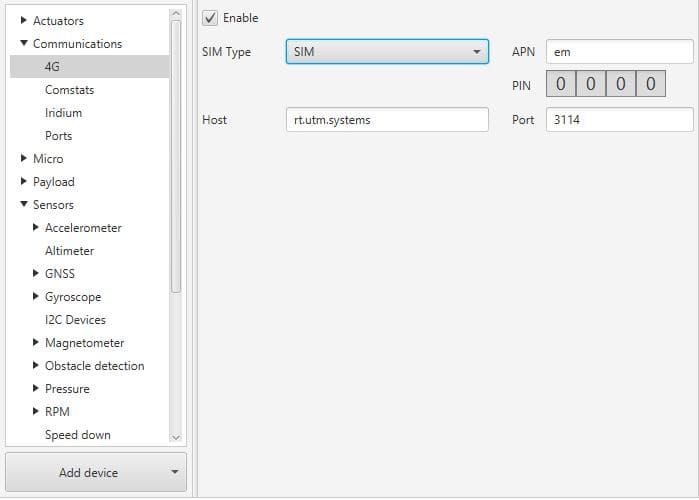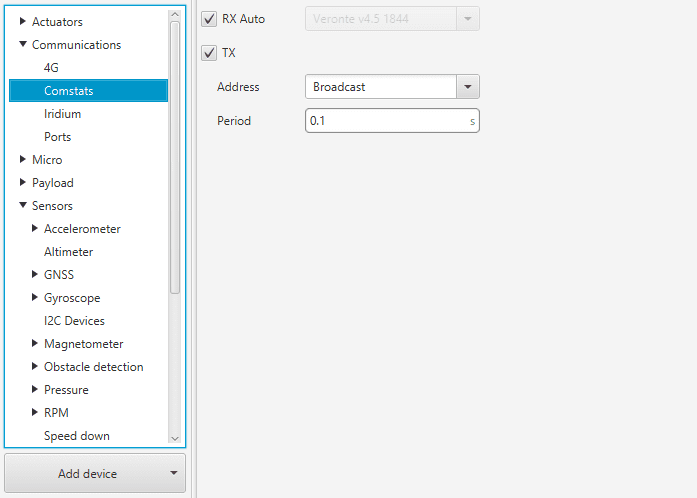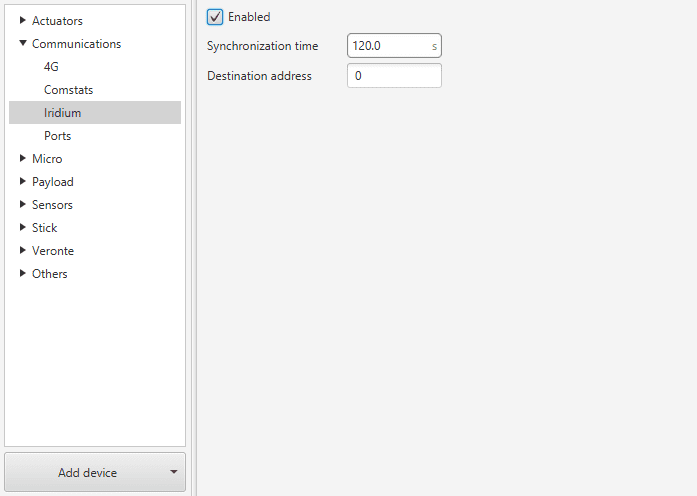Communications¶
Communications menu covers the configuration for alternative communication channels, statistics and routing.
4G¶
Checking the Enable box will enable the use of 4G communication through the Veronte LTE Consumer/Producer in the I/O Manager.
ESIM¶
The embebed ESIM in Veronte allows the user to send and receive telemetry using a commercial data provider.
The connection between the air unit and the ground station is stablished through the Veronte Cloud server.
To connect with Veronte Cloud the following parameters have to be set:
Host: rt.utm.systems
Port: 3114
Host and Port can be changed if the used server differs from Veronte Cloud, but the communication protocol does not change.

ESIM Configuration for 4G
Note
In order to use the embedded SIM card, the contract with the data supplier needs to be done through Embention. Please contact sales@embention.com for more information on availability, coverage, suppliers and prices in your country.
SIM¶
If needed it is also possible to install a custom SIM card on Veronte. PIN number and APN (Access Point Name) of the SIM card provider must be defined before enabling the 4G communication.
Warning
Introducing the wrong PIN number may block the SIM card.
Warning
The installation of the SIM card must be done by Embention during the production of the unit. Please make sure to indicate the interest on using a Custom SIM card when ordering new Veronte units.

SIM Configuration for 4G
Comstats¶
The Comstats feature allows Veronte to make an estimation of the overall quality of the communication channel.
Veronte will send periodically (If enabled) a message with its current communication statistics (Packets sent and received per second). Then, any other Veronte unit can receive this information and compare against its own statistics to estimate the average amount of packets lost in the communication.
The results of this estimation can be monitored in variables 2000 (RX Packet Error Rate) and 2001 (TX Packet Error Rate). These varaiables can be used to enable, for example, failsafe actions in case of degradation or loss of communications.
It is possible to configure the source or destination of the statistics, as well as the frequency at which the Comstats message is sent:
RX Auto: Enabling this option will use the first remote AP found. If this option is disabled, the user must choose manually the address of the unit used for Comstats calculation.
TX: When enabled, the unit will periodically send its Comstats message. The message can be sent to a specific unit or to all units on the network (Broadcast).

Comstats Configuration Menu
Note
Enabling Tx will enable Veronte to send its Comstats message, but in order to compute Packet Error rate it’s necessary to receive the Ts¡x message from a different unit.
Warning
Packet error rate is a good indicator of the status of the communication, but it is not representative of the radiolink status. For monitoring the status of the radiolink RSSI Variables (820-822) shall be used instead. Depending on the configuration it is posible to have bad Error rates with good RSSI (overloaded radiolink) or good Error rates with bad RSSI (degraded communication with low load on radiolink). For the best results, it is recommended to use a combination of both statistics for failsafe automations.
Iridium¶
Checking the Enable box will enable the use of Iridium communication through the Iridium Consumer/Producer in the I/O Manager.
Synchronization time: Transmission period.
Destination address: Address of the destination Iridium module.

Iridium Configuration Menu
Ports¶
Ports configuration allows the user to configure which communication ports (Commgr Ports in I/O Manager) will be used for communication.
By using the Route feature, it is also possible for Veronte to act as a Router, redirecting any messages received (with a specific Address destination) through a specific Port.
Each of the different ports can be configured as either of the following options:
Forward: Any messages generated by this unit (i.e. Telemetry or response messages to certain commands) will be sent through these ports.
Route: Any messages received at any Commgr Port with the defined address will be re-sent through the defined port. It is possible to route several addresses through the same port, but is not possible to route the same address through several ports. Only the first configured port will be used. Routing also applies to messages generated by the unit for the defined address.
Note that the same Port cannot be used as Forward and Route at the same time.
It is possible to define up to 2 routing setups, which can be switched unsing the Ports action in the Automations menu. Routing 1 will always be selected by deafult when booting Veronte.

Ports Menu
A practical example of the use of this menu are Veronte Ground configurations. These configurations will have configured a Routing of Address 2 (Pipe) through Port 1. This way, any messages that are received through a Commgr Port (i.e. through Veronte LOS), will be re-routed through Port 1 (USB) and received by Pipe Software, including any messages generated by Veronte Ground itself.
Warning
An incorrect Port configuration can disable USB communication. If this happens, Veronte will not be able to be detected through PIPE Software. If this is the case, please visit our Troubleshooting section on how to recover USB communication.
